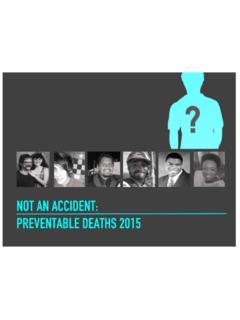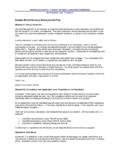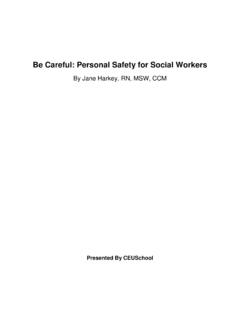Transcription of CHAPTER Legal, Ethical, and Safety Issues in the ...
1 Jones & Bartlett Learning, LLC. NOT FOR SALE OR DISTRIBUTION. CHAPTER . legal , ethical , and Safety Issues in the Healthcare workplace 2. Learning Objectives The student will be able to: Describe the legal relationship between patient and provider. Apply civil and criminal liability concepts to healthcare providers and consumers. Analyze six employment laws and their importance to the healthcare workplace . Examine the concept of ethics and its application to healthcare organizations. Discuss a healthcare ethical dilemma. DID YOU KNOW THAT? The healthcare industry is one of the most regulated industries in the United States. The National Defense Authorization Act of 2008 allows an employee to take 12 weeks of unpaid leave if a child, spouse, or parent has been called to active duty.
2 Voluntary hospitals are no longer exempt from lawsuits. According to civil law, surgery performed by a surgeon without consent could be considered assault and battery. Providers may order more tests and provide more services to protect themselves from medical malpractice lawsuits. Introduction To be an effective manager, it is important to understand basic legal and ethical prin- ciples that influence the work environment, including the legal relationship between the organization and the consumer the healthcare provider and the patient. ethical behavior, which is considered actions that are the right thing to do, not simply what is required by law, must also be described because the healthcare industry is fraught with difficult situations that involve ethical dilemmas.
3 It is the responsibility of the human 33. Jones & Bartlett Learning, LLC. NOT FOR SALE OR DISTRIBUTION. resources (HR) department to make employees knowledgeable in the information pre- sented in this CHAPTER . The basic concepts of law, both civil and criminal healthcare law, tort reform, employment-related legislation, Safety in the workplace , workplace ethics, and the provider patient relationship, healthcare organizational codes of ethics, public health ethics, research ethics, and workplace bullying will be described in this CHAPTER . Basic Concepts of Law in the Healthcare workplace The healthcare industry is one of the most heavily regulated industries in the United States.
4 Those who provide, receive, pay for, and regulate healthcare services are affected by the law (Miller, 2006a). Law is a body of rules for the conduct of indi- viduals and organizations. Law is created so that there is a minimal standard of action required by individuals and organizations. There exist laws created by federal, state, and local governments. When the judiciary system interprets previous legal decisions with respect to a case, they create common law (Buchbinder & Shanks, 2007). The minimal standard for action is federal law, although state law may be more stringent. Legislatures create laws that are called statutes.
5 Both common law and statutes are then interpreted by administrative agencies by developing rules and regulations that interpret the law. There exist civil and criminal laws that affect the healthcare industry. Civil law focuses on the wrongful acts against individuals and organizations based on con- tractual violations. In civil law, torts, derived from the French word for wrong, is a category of wrongful acts or negligence that can result in different types of health- care violations. To prove a civil infraction, you do not need as much evidence as in a criminal case. Criminal law is concerned with actions that are illegal based on court decisions.
6 To convict someone of a criminal activity, it has to be proved without a reasonable doubt of guilt. Examples of criminal law infractions would be Medicare and Medicaid fraud (Miller, 2006b). As stated earlier, torts are wrongdoings that occur to individuals or organizations regardless of whether a contract is in place. Medical malpractice cases are examples of torts. There are several different types of violations that can apply to health care. There are two basic healthcare torts: (1) negligence, which involves the unintentional act or omission of an act that could negatively contribute to the health of a patient, and (2) intentional torts, such as assault and battery and invasion of privacy (Buchbinder &.)
7 Shanks, 2007). An example of negligence is if a provider does not give appropriate care or with- holds care that results in damages to the patient's health. In the healthcare industry, intentional torts such as assault and battery would be a surgeon performing surgery on a patient without his or her consent (Miller, 2006c). An example of invasion of privacy would be the violation of patients' health records. Privacy relating to patient information is a major issue in the healthcare industry. As more information that is 34 CHAPTER 2 legal , ethical , and Safety Issues in the Healthcare workplace Jones & Bartlett Learning, LLC.
8 NOT FOR SALE OR DISTRIBUTION. confidential is shared electronically, there is an increased risk of invasion of privacy. These examples are categorized under the term medical malpractice. According to the American Heritage Dictionary, medical malpractice is the Improper or negligent treatment of a patient by a provider which results in injury, damage or loss (American Heritage Dictionary, 2000). According to the Institute of Medicine's landmark report To Err Is Human, medical malpractice results in approxi- mately 80,000 to 100,000 deaths per year. The Congressional Budget Office (CBO). found that in 2003 there were over 180,000 severe injuries due to medical negli- gence.
9 Harvard School of Medicine researchers indicate that in 2005 nearly 20% of hospital patients are injured during their care (Medical Negligence, 2011). Disputes over improper care of a patient have hurt both providers and patients. Patients have sued physicians because of the belief that the physician has not given the patient a level of care comparable with the standard of care established in the industry. Tort Reform Discussion As a result of the number of malpractice claims in the United States, malpractice insur- ance premiums have increased, which has resulted in the introduction of defensive medicine, which means that providers order more tests and provide more services than necessary to protect themselves from malpractice lawsuits (Shi & Singh, 2008a).
10 In addition, some states are no longer offering malpractice insurance, which means there are fewer physicians in needed areas resulting in geographic maldistribution of physicians. Malpractice insurance crises occurred during the 1970s and 1980s (Danzon, 1995). The Issues in the 1970s led to joint underwriting measures that required insurance companies to offer medical malpractice if the physician purchased other insurance. In some states, compensation funds were established to offset large award settlements. The number of malpractice suits decreased, but the amounts of awards were still huge. During the mid-1980s, the premiums rose again nearly 75%.


















